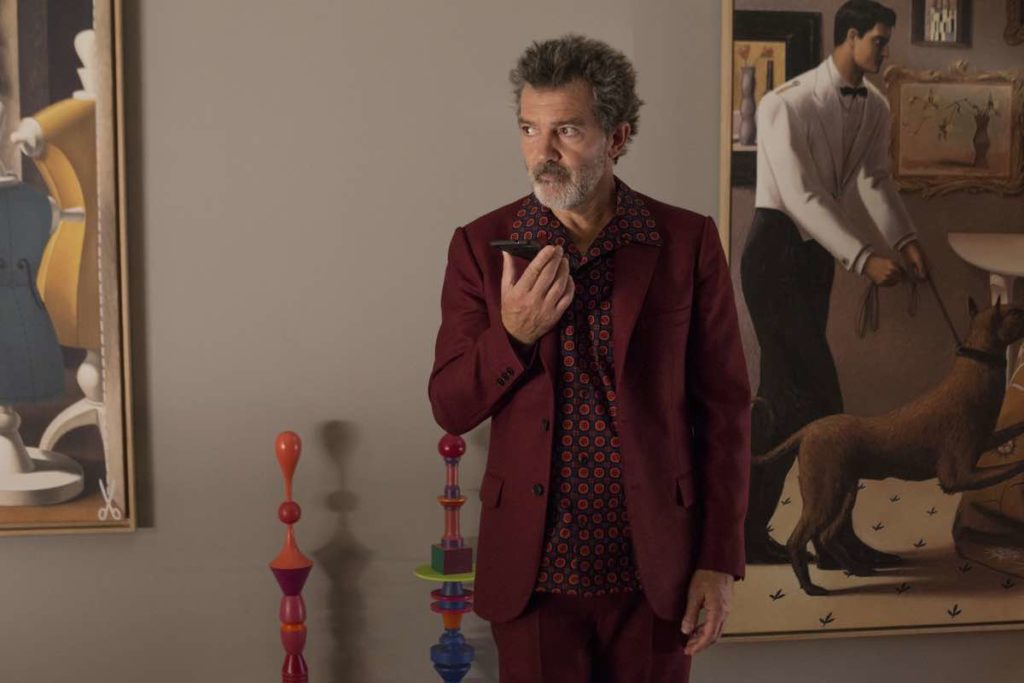In Pain and Glory, Almodovar brings together fiction and biography to create a knotty self-portrait.

The cinema of Almodóvar has always been a melange of influences, from Fassbinder and telenovelas to Doris Day musicals. The director has kept hold of his post-Franco punk spirit, even through his development into a mature director renowned on the world stage. With Pain and Glory, which won raves at Cannes and a Best Actor trophy for Antonio Banderas, the titan of Spanish cinema turns those influences inward, and questions what turns that inspiration into the impulse to create. Here, he continues the examination of reminiscence and loss that drove his last film, the relatively serious and straightforward Julieta. But in Pain and Glory, Almodovar brings together fiction and biography to create a knotty self-portrait.
Banderas plays Salvador Mello, ageing film director and Almodóvar surrogate along the lines of Toni from 8 ½. But rather than the creative block which drives Mastroianni’s character’s descent into the subconscious, Mello suffers from a physical one. Afflicted with numerous ailments which stop him from working on a film set, he ponders his life, career, and his surroundings as he begins to nurture a heroin habit. This might be a referential film-world, but there’s real life behind it, too. Birds and crickets populate the sound design. The crystal clear brightness of José Luis Alcaine’s photography draws out the heat and makes the textures more available.
Almodóvar’s lucid use of the strictures of melodrama in this decidedly slower, toned-down métier (maybe it’s the heroin) allows for a real breakthrough. The episodic structure, complete with mico-cliffhangers and constant act breaks, enables an appreciation of life’s left turns, even while things feel largely the same week to week. Reminiscences on youth might be triggered by senses from the past, or a direct encounter with those he considered ghosts. These memories peel back until reaching an event which could be considered the root of Mello’s trauma, the moment of his burgeoning artistic sensibility, but also a moment which is impossible to return to. Is it his Rosebud? Almodóvar’s?

Antonio Banderas is one of the great contemporary screen presences. He need do nothing more than watch his fellow actors and move at an almost imperceptible pace. And if no director has used him as often and fruitfully as Almodóvar, who discovered him, then here, Banderas uses his director back. He so fully inhabits Almodóvar’s public persona that the director seems to have transferred directly into the great actor. It’s like you’re not looking at Banderas at all. There’s a certain poetry to the casting that calls through the pair’s career together.
This uncanny exploration of persona is not limited to the casting. In a central sequence, actor-chum-cum-dealer Alberto (Asier Etxeandia) plays Mello in a one-man-show pontificating on his own influences, cinematic and personal. As he talks about his first love, a closeup of a face not dissimilar to Banderas appears, watching the play. It is Mello’s ex, coincidentally happening upon a play recounting his own experiences. In one moment of contrived suspended identity, Alberto plays a character based on Mello, clearly based on Almodóvar and played by his muse, with this other persona dropped into the mix, another double. Delicately, the film navigates the sequence without confusion, a mastery of control that pinpoints the Almodóvarian preoccupation with guiding one’s subconscious through images.
“Your mind won’t forget what heroin feels like,” says a doctor when Mello tries to get clean. The compulsion to relive a past feeling is where Pain and Glory willfully gets lost. The flashbacks harken back to Bad Education (2004), while the house that Mello grows up in looks just like the town that Liberto Rabal lives in the underrated Live Flesh (1998). Self-references are scattered throughout the film, and Almodovar wistfully acknowledging the necessity of evoking one’s own past works in order to come to terms with your legacy. That might make Pain and Glory, however dramatically engaging on its own merits, a somewhat unfulfilling experience to those not versed in the Almodovar-verse.
Pain and Glory has been referred to as the concluding part in a trilogy of Almodóvar stories about film directors, along with Law of Desire (1987) and Bad Education. But that presupposes that each one of his films hasn’t built upon the last, with ruptures in style here and there, leaning into what the audience knows of an Almodóvar film as a way of upending what we expect from him. Pain and Glory is as much a sequel to the heartbreak of Julieta as a part of that trilogy. That’s what makes Almodóvar such an endlessly rewarding director to follow, and why Pain and Glory feels in some ways surmative. But this is no end, merely the latest chapter in what has become an autobiography of anxieties and obsessions.
Discover another portrait of the artist
Joanna Hogg’s autobiographical The Souvenir
In Seventh Row’s ebook Tour of Memories, we uncover Joanna Hogg’s process for bringing this autobiographical story to life, through interviews with Hogg and her team and essays on the film.

